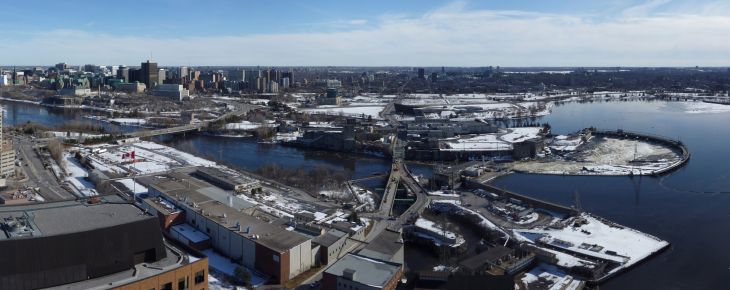


Emptied of life and commerce, the buildings now have a hollow, post-apocalyptic feel. The lighting is often poor, the rooms unheated. Nearly all of the large equipment and machinery that formerly supported Ottawa’s founding industry is gone, save for a single paper winder machine and a few massive iron hydropulper vats used to dissolve pulp and paper.
Sections of floors and walls are missing, cordoned off with yellow caution tape, and on inclement days, the cavernous buildings echo with the sounds of dripping rain leaking in.

Since mid-July, and perhaps for as long as another year or more, these and other volunteers with the Ottawa-based Workers’ History Museum will painstakingly document every square inch, inside and out, of the empty buildings on Chaudière, Albert, Victoria and Philemon islands, where the Eddys, Booths, Bronsons, and others built this city on lumber and hydroelectricity. And as the Domtar properties are transformed over the next 15 years into condominiums, offices, retail stores, restaurants and public spaces, the museum will continue to document the changes to the area, through photos, video and the oral histories of the people who once worked there.

For even in these desolate factories, hints of the non-stop industry that not-so-many-years ago filled their rooms can still be found. On a cinder-block hallway wall, for example, workers wrote their names and the years their careers started and ended, like some sort of industrial cemetery: “Gilles Lalonde. Feb-06-78. Mars-31-06. GL.” Nearby on the same wall, another worker documented a longer history:
E.B. EDDY
1860 – DETRUIT PAR LE FEU
1882 – DETRUIT PAR LE FEU
1900 – DETRUIT PAR LE FEU
2006 – FERMETURE PAR DOMTAR
2011 et 2012 – DEMOLIT PAR C.Y.F. INC.
“I think we forget the past,” says Naomi Gadbois, vice-president of the Workers’ History Museum. “We forget where we come from, and that’s dangerous.
“In a city like Ottawa, we think about the federal government and hi-tech — and hi-tech has proved to be ephemeral— but we need to know that we’re here today because of water and wood. This city would not exist without water and wood, and the hard work of the men, largely, who used those natural resources to build the community that we live in, and live very well in. It’s all due to people picking up tools and doing things, and that’s what we don’t want to lose. That’s what we’re interested in recording and preserving.”

Paul Harrison, a retired civil servant and stock photographer who is leading the volunteers through the documentary process, says he believes that within two or three years, an online 3-D tour of the buildings will be available.
“In the short-term — the next 10 years — it will be just an interesting curiosity. A lot of people — not just photographers — are fascinated with the notion of these buildings. Even in their ratty, old decrepit, empty way, these are beautiful buildings.
“They’re so atmospheric,” he adds. “So even just as a curiosity, it’ll be an attractive and unique experience for people who can’t ever get into such buildings. But beyond that, that place reeks of history. The entire Chaudiere Falls area does. And if we can capture this moment — what is left of these buildings now — it’s a big chunk of history.”

Formed four years ago and now boasting about 135 members, the Workers’ History Museum has already completed a number of projects and exhibits related to work culture and workers’ experiences in the Ottawa area: “The Struggle for Family Leave” tells the story of the evolution of family leave benefits, while “Britannia-on-the-Bay” documents the use of Britannia beach by workers as a popular amusement park and weekend getaway spot in the early decades of the 20th century. In another project, the museum brought to light the life of Cal Best, Canada’s first black ambassador and co-founder and president of the Civil Service Association of Canada, precursor to the Public Service Alliance of Canada.
The Chaudière project is by far the museum’s most ambitious to date. Every room on the site requires between 25 and 40 photos simply to chronicle the walls and ceilings, augmented by as many as 400 or more that zoom in on details such as machinery, lights, pumps and other fixtures. In their first eight shooting days, they’ve accumulated approximately 6,000 images.

Additionally, they’re gathering video, and plan to include a vast existing archives of historical photos and documents from the site, as well as past workers’ reminiscences.
Their job is one made much easier, however, through the assistance of both Domtar, which currently owns most of the 35 acres, and Windmill Developments, which hopes to start work on the site as early as next spring. Indeed, Windmill intends to incorporate many of the existing structures as possible into its plans, re-using materials and including historical elements in the site’s public spaces. Its 15-acre, 1.3-million square foot Dockside Green development in Victoria was one of 18 around the globe recognized by the Clinton Climate Initiative as being “Climate Positive.”


“They have a well-known reputation for sustainability and historic preservation,” says Gadbout. “They walk the talk.”
“For ever and ever,” adds Harrison, “the Workers’ History Museum will have a record of this site. Thousands of high-quality, well-organized images, so if somebody 100 years from now want to know what the fire-suppression systems looked like in a building from that period, they’ll be able to find out.

“These are unique shots of something that nobody else gets to see. And they’re going to tear it down or pretty it up, so it’ll disappear soon.”
Article by: Bruce Deachman, Ottawa Citizen
Link to original article here
 Wordpress
Wordpress






